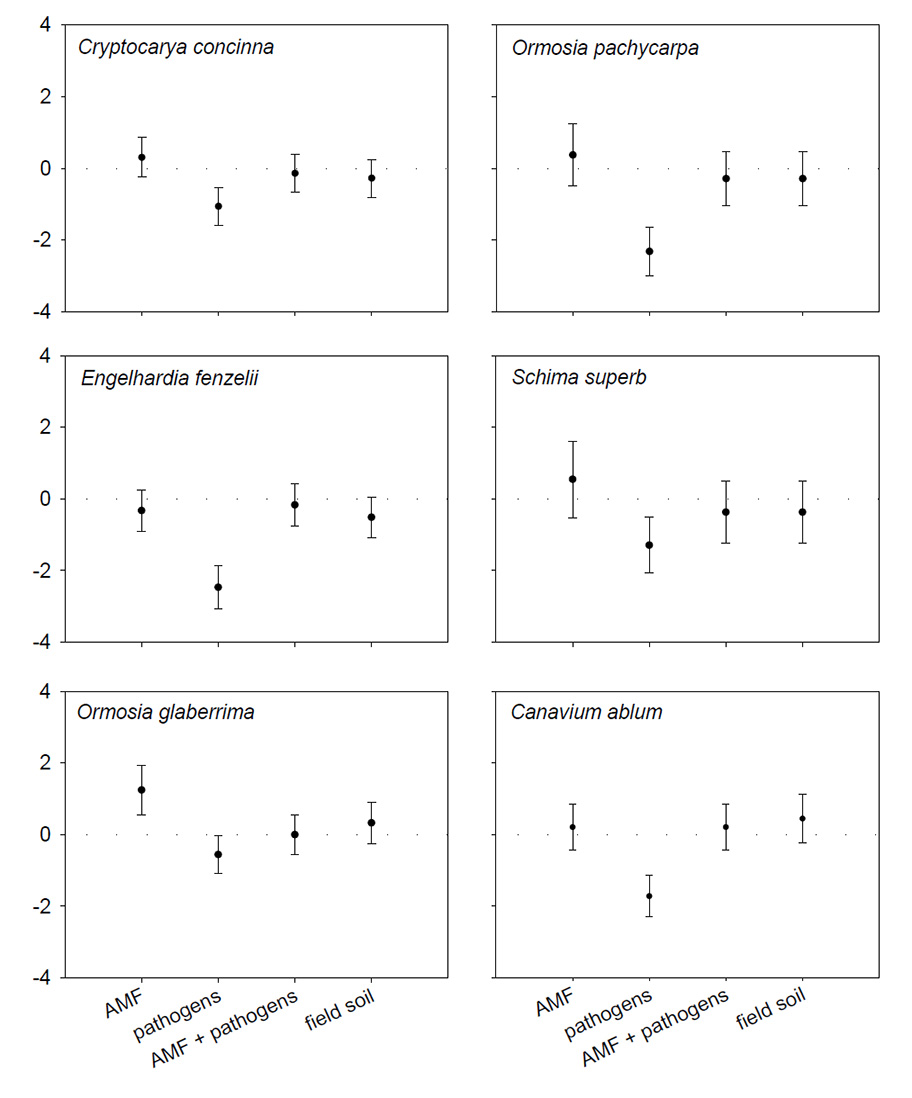
Ecological Archives E096-056-A2
Minxia Liang, Xubing Liu, Rampal S. Etienne, Fengmin Huang, Yongfan Wang, and Shixiao Yu. 2015. Arbuscular mycorrhizal fungi counteract the Janzen-Connell effect of soil pathogens. Ecology 96:562–574. http://dx.doi.org/10.1890/14-0871.1
Appendix B. Additional shade-house experiment comparing the field soil treatment with the AMF + pathogen treatment.
In the shade-house experiments 1 and 2, we used the field soil treatment to test whether AMF alter the effect of pathogens. The field soil treatment was the best representative of the microbial community in natural soil, but it may meanwhile contain other organisms besides AMF and pathogens. To confirm the additive effects of the field soil treatment was the interaction effect between AMF and pathogens, we conducted an additional shade-house experiment (experiment 3) in 2013. In this experiment, we included the four original soil fractions (AMF, pathogens, field soil and sterile soil) and a new AMF + pathogen treatment (the addition of both the AMF and pathogen fractions) extracted from soil samples beneath conspecific adults.
Materials and Methods. We used the same study species in experiment 3 as in experiments 1 and 2, including Cryptocarya concinna, Ormosia pachycarpa, Engelhardia fenzelii, Schima superba, Ormosia glaberrima and Canavium album. Using the same seed collecting and seedling germination procedures, we transplanted newly geminated seedlings into pots containing sterilized field soil and then treated them with soil microbial fractions from soil beneath conspecific adult trees (For each species, n = 5 microbial fractions × 30 replicates).
We collected soil samples from three adult trees for each species, thoroughly mixed and divided them into 50 g subsamples, and then passed though a 250-μm sieve separately into 100 mL suspensions. For each group of four subsamples, we used the first subsample to extract (1) AMF and (2) soil pathogens, and also the second subsample to extract AMF and pathogens for (3) AMF + pathogen treatment. We used the third as (4) field soil and sterilized the fourth subsample by gamma radiation as (5) sterile soil. After inoculating, seedlings were allowed to grow for 6 months, and then we harvested and measured the aboveground, belowground and total dry biomass.
We calculated the log odds ratios comparing seedling survival in AMF, pathogens, AMF + pathogens, and field soil pots vs. sterile pots, and the mean biomass for each treatment, respectively. Log survival odds ratios that are significantly larger than 0 indicate positive feedbacks of soil microbes on seedling survival and negative values indicate negative feedbacks. We analyzed the total biomass using analysis of variance (ANOVA), to compare seedling growth among the four soil microbial treatments for each species.
Results. For all six species, both seedling survival (Fig. C1) and growth (Fig. C2) were significantly limited by pathogens extracted from soils beneath conspecific trees comparing to field soil and sterile soil treatments. The beneficial effects of AMF were also detected for all species, with weak effects on seedling survival (Fig. C1) and much significant effects on seedling growth (Fig. C2). These results were consistent with the results of shade-house experiments 1 and 2.
In "AMF + pathogen" treated pots, we detected no significant effect on seedling survival (Fig. C1) or growth (Fig. C2) comparing to sterile soil pots. These effects were exactly the same as feedback effects in field soil pots.
Conclusions. When seedlings were treated with microbial fractions extracted from soil samples beneath conspecific adults, their performances had no difference in the AMF + pathogen treatment and the field soil treatment. As the AMF + pathogen treatment examined specifically the effects of pathogens within the context of the mycorrhizal community (interaction effects), our results demonstrated that the beneficial effect of AMF neutralized the inhibition effect of pathogens as we hypothesized. Hence we can infer that the same phenomenon we observed in the field soil treatment, which also contained both AMF and pathogens, was also caused by the interaction effects between them.
Fig. B1. Feedback effects of soil biota on seedling survival in shade-house experiment 3. The survival of six tree species to AMF, pathogens, AMF and pathogens, and field soil fractions obtained beneath adult tress of their own species, compared to sterile soils. Survival log odds ratios above 0 indicate positive effects and log odds ratios that are lower than 0 indicate negative effects. Error bars represent standard errors.
Fig. B2. Feedback effects of soil biota on seedling growth in shade-house experiment 3. The growth responses of six tree species to AMF, pathogens, AMF + pathogens, field soil and sterile soil fractions obtained beneath adult tress of their own species. Bars represent the mean total biomass ± SE. Different lowercase letters represent significant differences among treatments (P < 0.05).